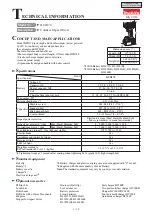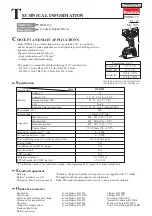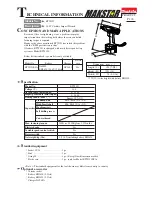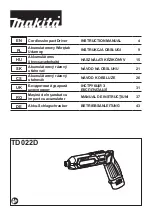
11 Sp
Llave de Impacto de 13mm
Guía General de Diagnóstico de Averías
Problema
Causa(s) Posible(s)
Accion a tomar
La herramienta
funciona
lentamente o no
funciona
La herramienta
expulsa residuos de
agua
1. Hay acumulación de arenillas o
goma
2. La herramienta no tiene aceite
3. La presión de aire es muy baja
4. Hay una fuga de aire en las
mangueras
5. Ocurre una baja de presión
6. Una de las aletas del rotor del
motor está desgastada
7. Uno de los baleros del motor está
desgastado
1. Hay agua en el tanque
2. Hay agua en las líneas de aire/
mangueras
1. Enjuague la herramienta con aceite para herramientas
neumáticas, diluyente de gomas, o una mezcla de partes
iguales de aceite de motor SAE 10 y querosene. Si no se usa
aceite para herramientas, lubrique la herramienta después
de la limpieza.
2. Lubrique la herramienta según las instrucciones de
lubricación
3. a. Aumente la presión del regulador a lo máximo
b. Aumente la presión del compresor a lo máximo mientras
la herramienta funciona libremente
4. De haber fugas en las mangueras apriete bien las conecciones
5. a. Cerciórese de que la manguera sea del tamaño adecuado.
Las mangueras largas o herramientas que estén usando
grandes volumenes de aire tal vez necesiten una manguera
con un diámetro interno de 13mm (1/2”) o más según la
longitud total de la manguera
b. Nunca conecte varias mangueras con conectores rápidos.
Ésto ocasiona bajas de presión adicionales y reduce la
potencia. Conecte las mangueras directamente
6. Reemplace la aleta del rotor
7. Saque los baleros y revíselos a ver si están oxidados, tienen
impurezas o los anillos están desgastados. Reemplácelos o
límpielos y lubríquelos con grasa para baleros
1. Drene el tanque (Lea el manual del compresor de aire).
Póngale aceite a la herramienta y déjela funcionar hasta que
no expulse más agua. Una vez más póngale aceite a la
herramienta y déjela funcionar por unos 1 ó 2 segundos
2. a. Instale un filtro/ separador de agua.
NOTA:
Los
separadores funcionan bien sólo cuando el aire que está
circulando está frío. Coloque este filtro separador lo más
lejos posible del compresor
b. Instale un secador de aire
c. Si el separador original no separa toda el agua del aire,
instale un filtro de aire de correa.
Funcionamiento
(Con’t)
de longuitud deben tener un diámetro
interno de 13mm (1/2”).
Nunca
cargue
una herramienta por la manguera o
hale la manguera para mover la
herramienta o un compresor. Mantenga
las mangueras alejadas del calor, aceite
o puntas afiladas, reemplace cualquier
manguera que esté dañada,
deteriorada o desgastada.
!
ADVERTENCIA
Almacenamiento
La llave de impacto se debe lubricar
antes de almacenarla. Siga las
instrucciones de lubricación excepto el
paso 4. Sólo déjela funcionar 2 ó 3
segundos en vez de 20 ó 30 segundos
ya que debe almacenar la con más
aceite en el mecanismo de impacto.
Servicio Técnico
Para mayor información referente al
funcionamiento o reparación de este
producto comúniquese con el
distribuidor de Campbell Hausfeld más
cercano a su domicilio.
Operation
LUBRICATION
Proper lubrication is the owner’s
responsibility. Failure to lubricate the
air tool properly will dramatically
shorten the life of the tool and will
void the warranty.
This impact wrench
requires lubrication
BEFORE the initial use and BEFORE and
AFTER each additional use.
Impact wrenches require lubrication
throughout the life of the tool and must
be lubricated in two separate areas: the
air motor and the impact mechanism. Air
tool oil is recommended because this oil
cleans, lubricates and inhibits rust all in
one step.
AIR MOTOR LUBRICATION
The motor must be lubricated daily. An
air motor cannot be oiled too often.
Disconnect the
impact wrench
from the air supply before lubricating.
1. Disconnect the impact wrench from
the air supply.
2. Turn the impact wrench upside down.
3. While pulling the trigger, squeeze
approximately a 1/4 oz. of airtool oil
in the air inlet. Then, push the
forward and reverse button in both
directions.
After an air tool
has been
lubricated, oil will discharge through
the exhaust port during the first few
seconds of operation. Thus, THE
EXHAUST PORT MUST BE COVERED WITH
A TOWEL before applying air pressure.
FAILURE TO COVER THE EXHAUST PORT
CAN RESULT IN SERIOUS INJURY.
4. Connect the impact wrench to the air
supply and cover the exhaust port
with a towel. Run the impact wrench
in both the forward and reverse
directions for 20 to 30 seconds. Oil
will discharge from the exhaust port
when air pressure is applied.
!
WARNING
!
WARNING
!
CAUTION
2
1/2” Impact Wrench
IMPACT MECHANISM LUBRICATION
Lubricate the impact mechanism
monthly.
Disconnect the
impact wrench
from the air supply before lubricating.
1. Disconnect the impact wrench from
the air supply.
2. Remove the slotted screw or allen
head screw from the oil port hole.
3. Squeeze approximately 1 oz. of air
tool oil in the oil port hole. Replace
the screw.
4. Reconnect the air supply to the
impact wrench and run for 20 to 30
seconds. Lubricate the entire impact
mechanism by rotating the tool
upside down and sideways while
running the tool.
5. Remove the screw and hold the oil
port hole over a suitable container to
allow excess oil to drain. Sometimes
triggering the tool when dumping
the oils helps to force out the excess
oil.
6. If the oil is dirty, repeat the
procedure above until the oil comes
out clear. Install the screw and
tighten. The residual oil remaining in
the impact mechanism chamber is all
that is needed for proper lubrication.
SPEED ADJUSTMENT
The impact wrench should never be
used to set torque. Use a torque
wrench to set the torque. All models
are equipped with regulators for speed
adjustment.
To remove lugs or bolts, set the
regulator to the maximum setting.
When installing, always use a torque
wrench to attain the proper torque of
the lugs or bolts.
When re-
assembling be
careful not to overtighten. Bolts may
fail or cause a hazardous condition. Be
sure to set the regulator to the
minimum setting then use a torque
wrench to set torque.
!
WARNING
!
WARNING
NOTE:
It is not recommended to install a
quick coupler between the tool and the
whip hose.
Using fittings or air hoses which are too
small can create a pressure drop and
reduce the power of the tool. For 3/8,
1/2 and 3/4” impact wrenches use 3/8”
(I.D.) fittings with 1/4” NPT threads.
Most compressors are shipped with a
short, 1/4” I.D. hose. For proper
performance and more convenience,
use a 3/8” I.D. hose. Hoses longer than
50 feet should have a 1/2” I.D.
For 1” impact wrenches use 1/2” (I.D.)
fittings with 1/2” NPT threads and a
1/2” I.D. hose. Hoses longer than 50
feet should have a 1” I.D.
Never carry a tool
by the hose or pull
the hose to move the tool or a
compressor. Keep hoses away from
heat, oil and sharp edges. Replace any
hose that is damaged, weak or worn.
Storage
The impact wrench must be lubricated
before storing. Follow the air motor
lubrication instructions with an
exception to step 4. Only run the
impact wrench for 2 to 3 seconds
instead of 20 to 30 seconds because
more oil needs to remain in the impact
wrench when storing.
Technical Service
For information regarding the
operation or repair of this product,
please call 1-800-543-6400. If you are
calling from Ohio or outside the
continental United States, please call 1-
513-367-1182.
!
WARNING






























